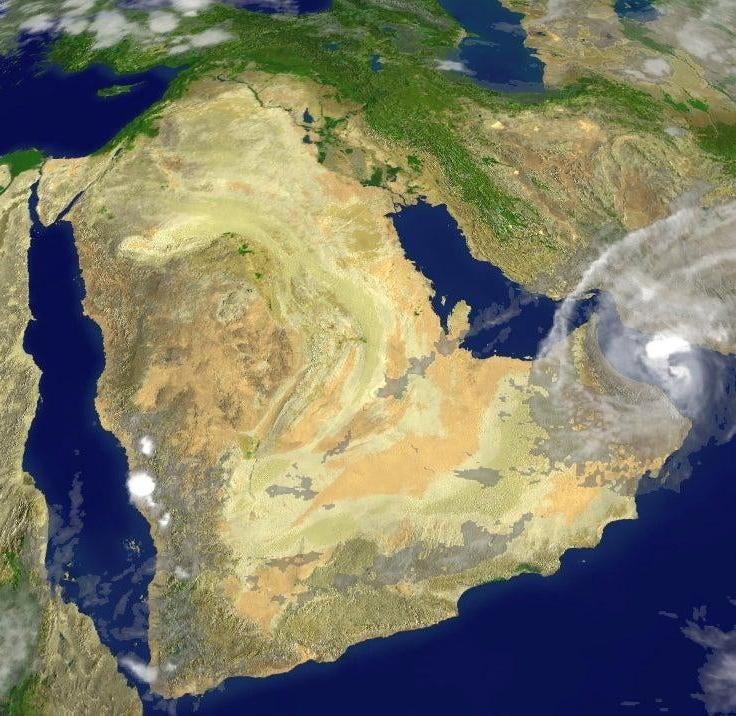A team of geneticists has sequenced 137 modern human genomes from the Middle East, shedding new light on how humans arrived in the region and how those populations changed as areas dried up.
The research goes a long way in a region where precious little is left of a fossil record. The recent aridification of the Arabian peninsula, especially, means that bones can get so brittle they can simply disintegrate when archaeologists pick them up, as Mathew Stewart, a zooarchaeologist at the Max Planck Institute for the Study of Human History, recently told Gizmodo. Genetic evidence is easily lost to time. The team’s results draw on modern samples from eight different groups in the Levant, Iraq, and Arabia. Ancient genomes that had previously been constructed were also included in their analysis, which is published this week in the journal Cell.
“The Middle East is an important region to understand human history, migrations, and evolution: it is where modern humans first expanded out of Africa, where hunter-gatherers first settled and transitioned into farmers, where the first writing systems developed, and where the first major known civilizations emerged,” said Mohamed Almarri, a geneticist at the Sanger Institute in England and lead author of the study, in a Cell press release. “However, despite this importance, the region has been historically understudied in genomic studies.”
Expansions out of Africa, agricultural developments, and even climatological events can be interpreted from the genomic data, Almarri’s team said. Looking at ancient genomes from past Middle Eastern populations, the team determined that populations were able to grow as people began to settle down and started farming.

The researchers used a relatively new sequencing approach, called linked-read sequencing, that allowed them to reconstruct population histories as far back as 100,000 years ago. Geneticists can use the approach to analyse more of the genome, in this case identifying millions of genetic variants unique to Middle Eastern populations.
The researchers found that Middle Easterners descend from a population that left Africa between 50,000 and 60,000 years ago. That makes a mini-mystery of the 88,000-year-old human finger bone found at a prehistoric lake site in Saudi Arabia; it may be that bone belonged to a human group that dispersed early and did not contribute to the modern gene pool in the region. Many anatomically modern humans left Africa earlier, but these genetics suggest that modern Middle Eastern populations descended from the group that left Africa around 50,000 years ago.
“Our study fills a major gap in international genomic projects by cataloguing genetic variation in the Middle East,” said co-author Chris Tyler-Smith, also a geneticist at the Wellcome Sanger Institute, in the Cell release. “The millions of new variants we found in our study will improve future medical association studies in the region. Our results explain how the genetics of Middle Easterners formed over time, providing new insights, which complement knowledge from archaeology, anthropology, and linguistics.”

Almarri and his co-author Marc Haber, a geneticist at the University of Birmingham in England, said in an email that a benefit of the research is being able to connect archaeological and ancient climate data with shifts in local population genetics. Population bottlenecks in Arabia 6,000 years ago and in the Levant 4,200 years ago point to moments when the verdant east began to dry up, the study authors said, with rapid aridification causing decreases in population sizes.
Based on when different groups mixed thousands of years ago, the team also evaluated how Semitic languages might have spread beyond the Levant, specifically pointing to the Bronze Age as a major point of intermixing, based on coincident timing between some of the genetic variations and previously determined dates for language divergence and evolution. The researchers also noted that Arabian populations have a much lower amount of Neanderthal ancestry than other Eurasians, indicating there was less admixture between our extinct close relatives and Arabian humans.
“It is exciting to see so much new genomic data from a crucial part of the world. It is interesting to see the genetic coherence of recent social groups, and, as the authors say, for things like understanding modern health, it is important to have good sampling of people around the world,” Huw Groucutt, a paleoanthropologist at the Max Planck Institute for the Science of Human History who wasn’t involved with the recent study, said in an email. He added, however, that there are limitations to genomic studies and that the recent team’s interpretations should be considered just that.
The team intends to follow up the research with a look at adaptation signals in the dataset, which could indicate how populations in the Middle East learned to survive in their environments when the region dried up. The recent discovery of a trove of animal bones, including human remains, in a Saudi lava tube will likely help in efforts flesh out this genetic portrait of the Middle East.
